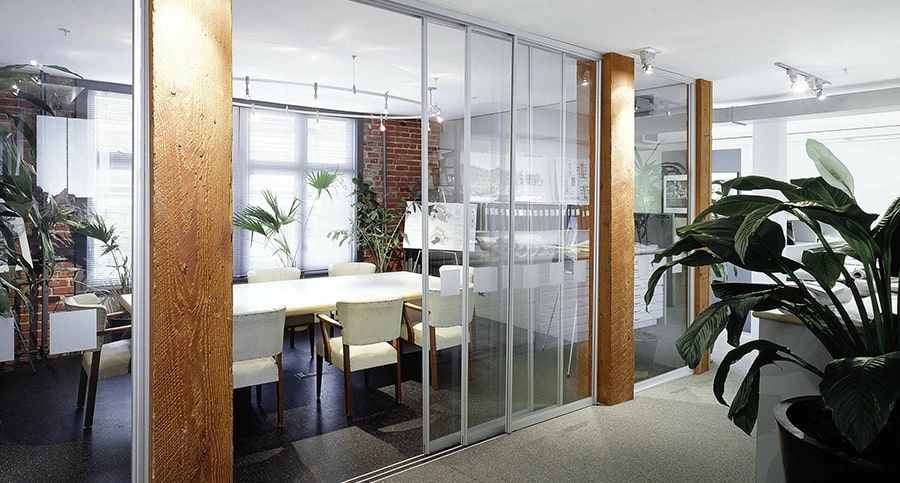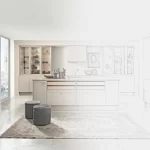In the ever-evolving world of interior design, room dividers play a pivotal role in creating functional, versatile, and aesthetically pleasing living spaces. Among the various types of room dividers, sliding door room dividers are the most unique and elegant solution. German manufacturing has long been synonymous with precision and quality. In this blog, we will explore the art of creating sliding door dividers and how to choose the correct materials for the panels based on your specific needs.
The Elegance of Sliding Door Room Dividers
Room dividers have evolved from simple folding screens or makeshift curtains. Sliding door room dividers have captured the imagination of interior designers and homeowners for their sleek appearance and practicality. These dividers offer several advantages:
- Space Efficiency: Sliding doors move horizontally, allowing you to save space by not needing clearance for outward or inward swinging doors. This feature makes them ideal for small apartments, open-plan spaces, or any room where space is limited.
- Aesthetic Appeal: Sliding door room dividers provide a modern and stylish look with customization options to match your interior décor, creating a seamless and sophisticated atmosphere.
- Functionality: These dividers are highly functional as they are versatile for separating or connecting rooms, providing privacy or open space as needed. This adaptability makes them a valuable addition to any home.
- Sound Insulation: Many sliding door dividers come with options for soundproofing, ensuring that they not only divide the space but also maintain acoustic privacy.
The Craftsmanship of German Manufacturing
When we talk about sliding door room dividers the manufacturing process plays a crucial role in ensuring quality and durability. Germany is renowned for its precision engineering and meticulous craftsmanship, making it an ideal hub for the production of room dividers.
German manufacturers prioritise the following aspects:
- Quality Materials: German manufacturers are known for sourcing high-quality materials. They often use tempered glass, aluminum frames, and premium wood or wood veneers. These materials ensure that the sliding door dividers are visually appealing and long-lasting.
- Engineering Excellence: German engineers are committed to creating innovative and functional designs. Sliding door mechanisms have been tested to ensure smooth and quiet operation, while safety features are integrated to prevent accidents.
- Sustainability: Environmental consciousness is a hallmark of German manufacturing. Many manufacturers prioritise sustainability by using eco-friendly materials, efficient production processes, and recyclable components.
- Customization: German manufacturers understand the importance of personalization. They offer a wide range of finishes, colours, and design options, ensuring that the room divider complements your space perfectly.
- Reliability: Reliability is a cornerstone of German manufacturing. The reputation of German-made products is built on the principle that these room dividers will stand the test of time, making them a valuable investment for homeowners.
You may like to read this: Streamlined Elegance and Smart Space Management: The Advantages of Sliding Doors and Sliding Door Closets
Choosing the Right Material for Your Sliding Door Room Divider
Selecting the right material for the panels of your sliding door room divider is a critical decision. The choice of material affects not only the aesthetics but also the functionality of the room divider. To make an informed decision, consider the following factors:
- Space Functionality: Determine the primary function of the room divider. If you need soundproofing or privacy, consider materials like solid wood or soundproof glass. For an open and airy feel, opt for translucent or frosted glass.
- Aesthetic Preferences: Your choice of material should align with your interior design. Wood, for instance, exudes warmth and can complement traditional or rustic decor, while glass provides a modern and sleek appearance.
- Maintenance Requirements: Some materials, like wood, may require more maintenance than others. Consider your willingness and ability to care for the material over time.
- Lighting: Materials like glass and acrylic allow natural light to pass through, making your space feel brighter. This can be a crucial consideration in rooms where light is limited.
- Durability: Assess the durability of the material. High-traffic areas may benefit from robust materials like tempered glass or metal frames.
Now, let’s delve into some popular material choices for sliding door room dividers:
Glass Panels:

Glass is an elegant choice that allows light to flow through, creating a sense of spaciousness. Here are a few variations of glass to consider:
- Clear Glass: Ideal for creating a seamless look and maintaining a sense of openness.
- Frosted Glass: Offers privacy while still allowing light to filter through.
- Tinted Glass: Provides both privacy and a unique aesthetic.
Wood Panels:
Wooden panels provide a warm and classic look, making them perfect for traditional or rustic interiors. Wood can be stained or painted in various finishes to match your decor.
Acrylic Panels:
Acrylic panels are lightweight and versatile. They can mimic the appearance of glass while being less fragile, making them a safe and cost-effective choice.
Metal Panels:
Metal panels combined with glass create a contemporary and industrial look. They are sturdy and low-maintenance, making them suitable for high-traffic areas.
Fabric Panels:
Fabric panels are a unique choice that allows for creativity and customization. They come in various colors and patterns, offering a soft and artistic touch./
Combination Panels:
Many room dividers feature a combination of materials. For example, a wood and glass combination can offer warmth and transparency, while a metal and acrylic combination can create an ultra-modern look.
You may like to read this: Sliding Door Wardrobes: Enhancing Bedroom Aesthetics With Modern Design
Choosing the Right Room Divider for Your Needs
To choose the right sliding door room divider for your space, follow these steps:
- Assess Your Space: Examine the room and consider its layout and size. Determine the function of the divider: Is it for separating a home office from a living area, creating a private bedroom in a studio apartment, or dividing a dining area from a kitchen?
- Consider Your Style: Think about your interior design style. Do you prefer a modern, minimalist look or a more traditional ambiance? The material and design of the room divider should harmonise with your aesthetic preferences.
- Prioritise Functionality: If you need sound insulation, prioritise materials that offer this feature. If natural light is essential, consider translucent or clear materials. Safety features, especially if you have children or pets, should also be considered.
- Set a Budget: Determine your budget for the room divider. High-quality materials and craftsmanship may come with a higher price tag, but they can offer better longevity and aesthetics.
- Consult a Professional: If you’re unsure about the design, materials, or installation process, consider consulting an interior designer or a professional in room dividers. They can provide valuable insights and recommendations tailored to your needs.
Conclusion
Sliding door room dividers are not just functional partitions but also design elements that can transform the feel and functionality of your living space. When it comes to selecting the right material for the panels, it’s essential to consider your specific needs, including aesthetics, functionality, and maintenance requirements. German manufacturing of room dividers is renowned for its quality and precision, making it an excellent choice for those who want a perfect balance of form and function with high-quality products.













